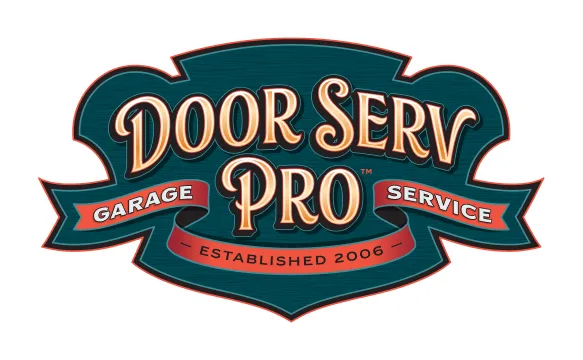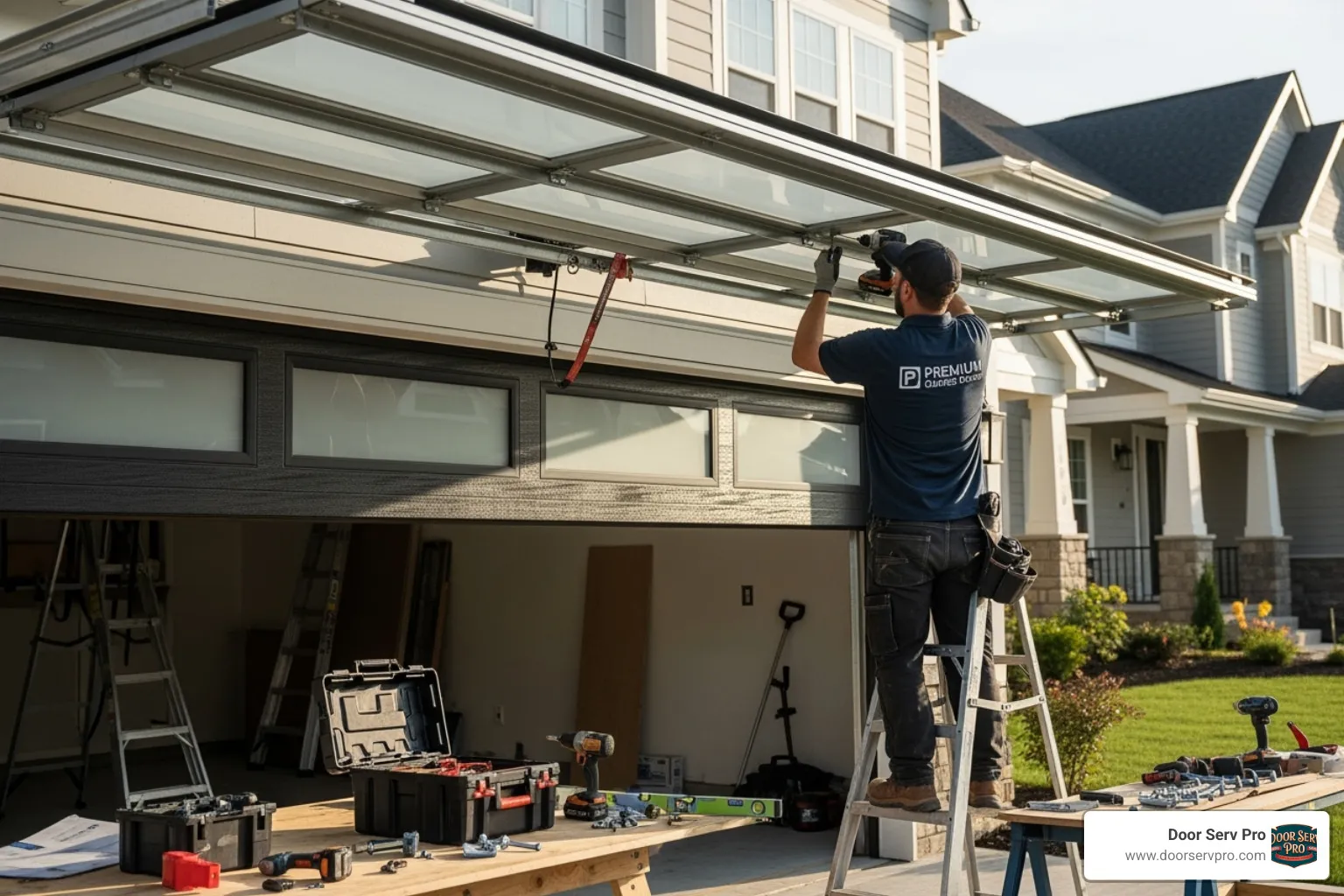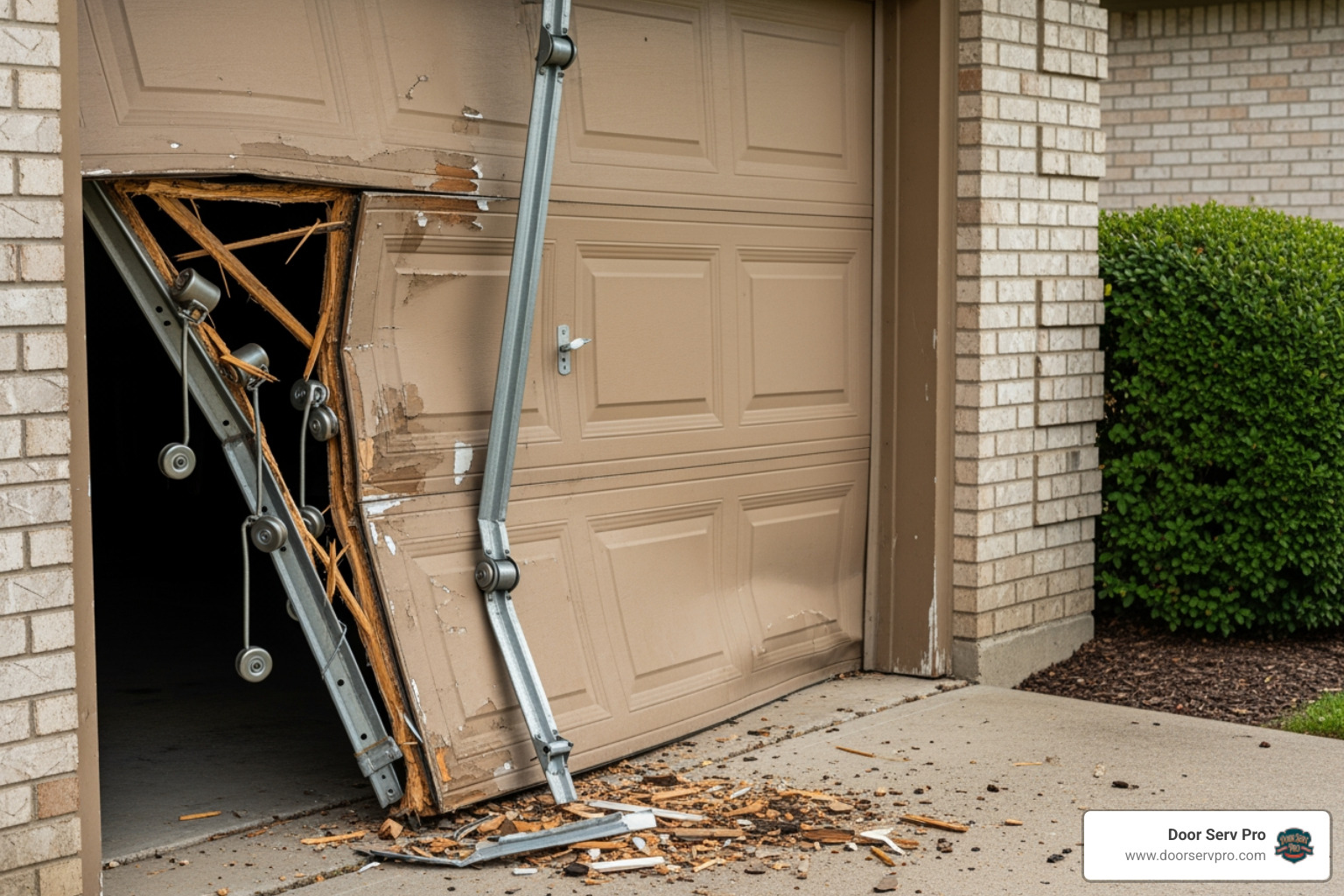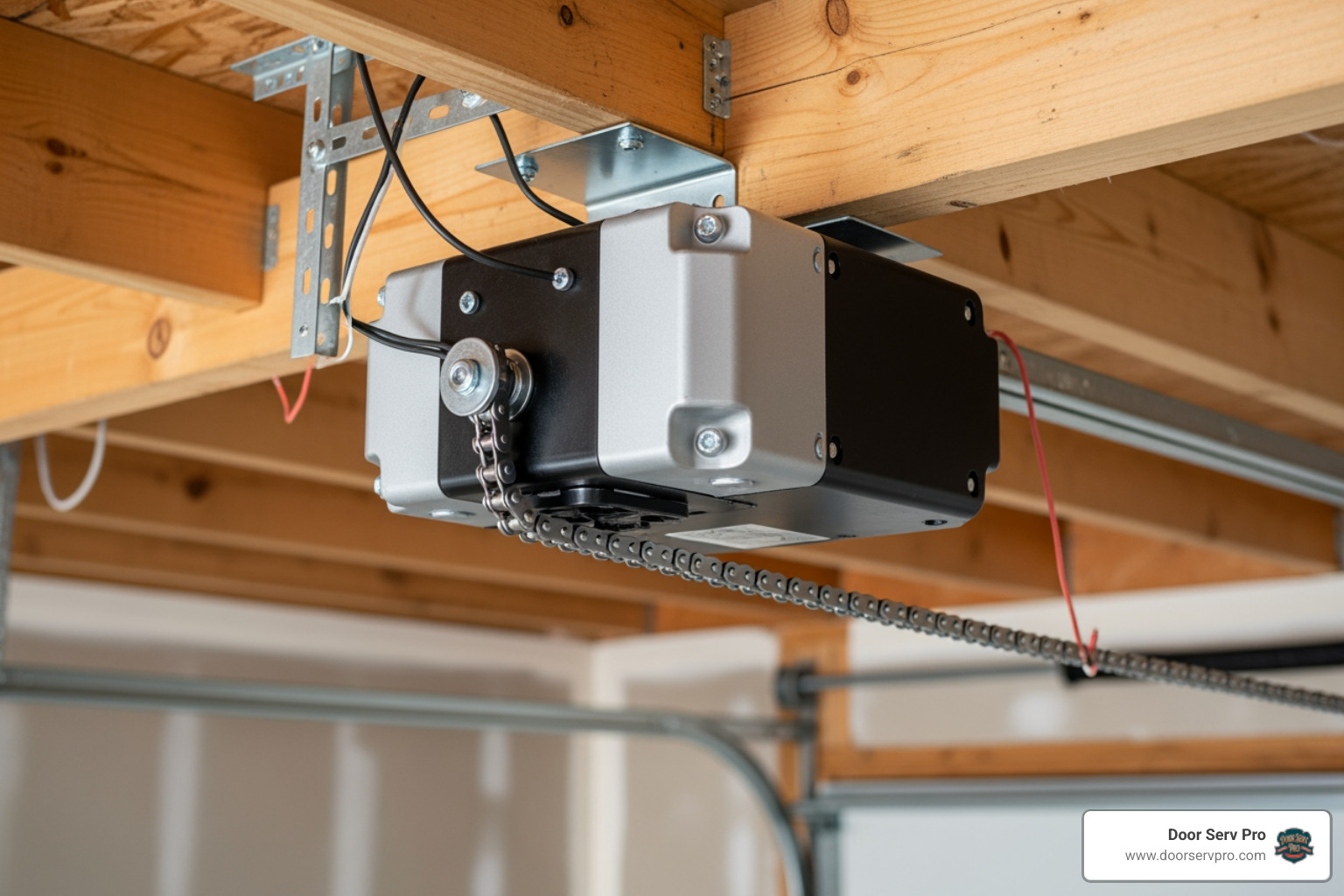Why Understanding the Garage Door Installation Process Matters
The garage door installation process involves several complex steps that can significantly impact your home's security, energy efficiency, and curb appeal. Whether you're dealing with a broken door that's left you stranded or planning an upgrade, understanding what's involved helps you make the best decision for your situation.
Key Steps in the Garage Door Installation Process:
- Preparation - Measuring the opening, selecting materials, and clearing the workspace
- Removal - Safely disconnecting the old door and releasing dangerous spring tension
- Assembly - Installing panels, tracks, and hardware in precise alignment
- Spring Installation - Mounting and tensioning springs (the most dangerous step)
- Final Setup - Installing openers, safety features, and performing balance tests
The process typically takes professionals a few hours but can require 8-10 hours for DIY attempts. Most importantly, garage door springs are under extreme tension - mishandling them has caused serious injuries and even fatalities.
Research shows that garage door replacement consistently ranks as one of the highest ROI home improvements, often returning 90% or more of the investment. Your garage door makes up about one-third of your home's facade, making it a critical element for both function and appearance.
The big question facing most homeowners is simple: should you tackle this as a DIY project or hire professionals? The answer depends on your experience, available time, and comfort level with potentially dangerous spring systems.
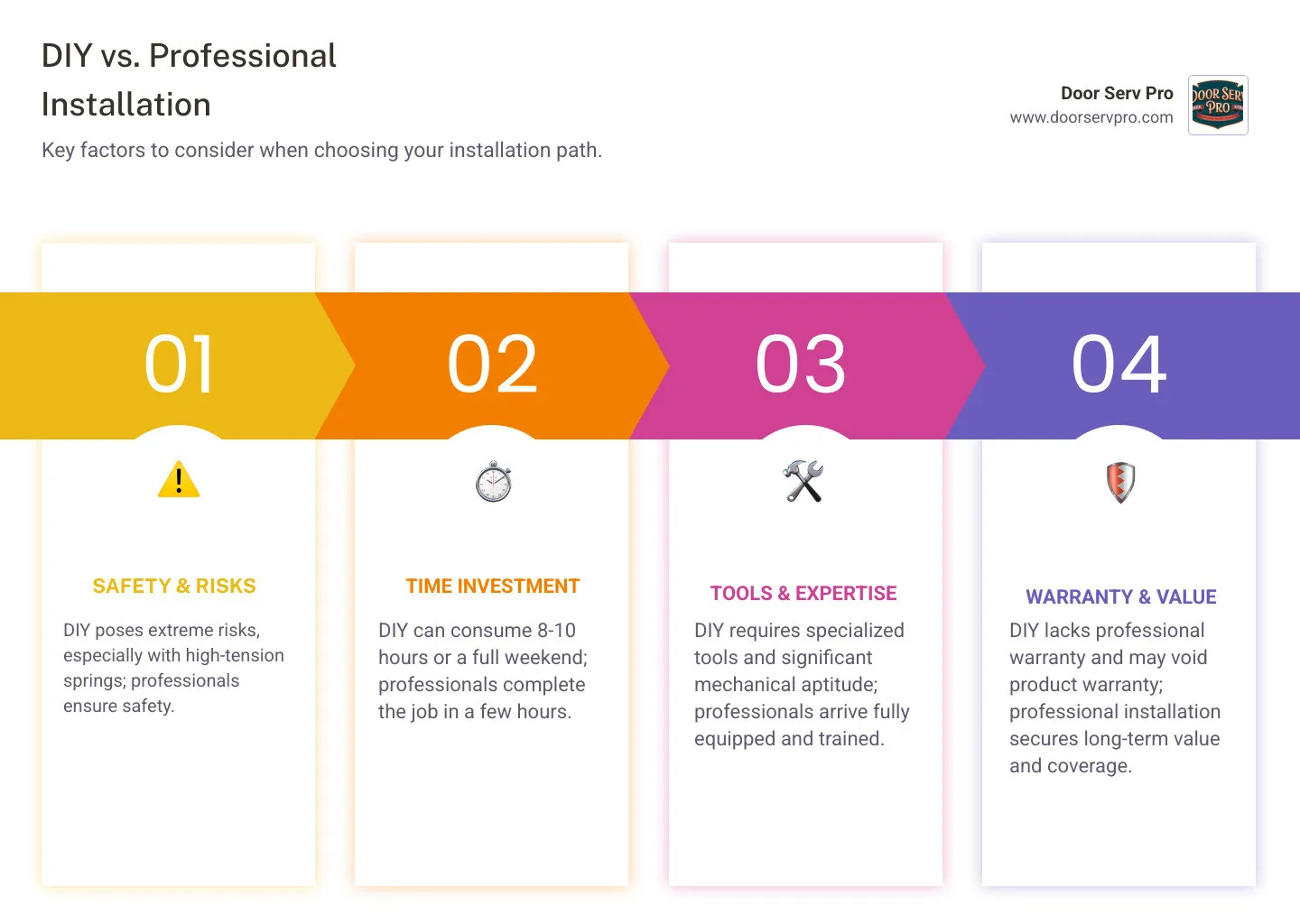
Before You Begin: Essential Preparation and Planning
Proper preparation is the key to a smooth garage door installation process. Skipping this phase can lead to wrong measurements, missing tools, or other headaches on installation day. Whether you're going DIY or hiring professionals like our team at Door Serv Pro, these steps are crucial.
Choosing Your New Garage Door
Your garage door is a major part of your home's curb appeal, so the right choice balances aesthetics with your specific needs.
Material selection is the first step.
- Steel doors are popular for being tough, low-maintenance, and versatile in design.
- Wood doors offer classic, customizable charm but require regular care to protect them from weather.
- Aluminum doors are lightweight, rust-proof, and ideal for modern designs with glass panels.
- Composite doors provide the look of wood without the maintenance, resisting rot and weather damage.
For more on the latest options, see our guide on Innovative Materials Used in Modern Garage Door Installation.
Style selection should complement your home's architecture. A cohesive look can be achieved by matching the garage door design to your home's existing windows. Insulation (measured by R-value) is also important, especially if your garage is attached to living spaces. A well-insulated door regulates temperature, lowers energy bills, and reduces noise. Learn more about The Role of Insulation in Residential Garage Door Installation to see how it can transform your garage.
Taking Critical Measurements for a Perfect Fit
Accurate measurements are non-negotiable to avoid costly mistakes. Don't assume your opening is a standard size.
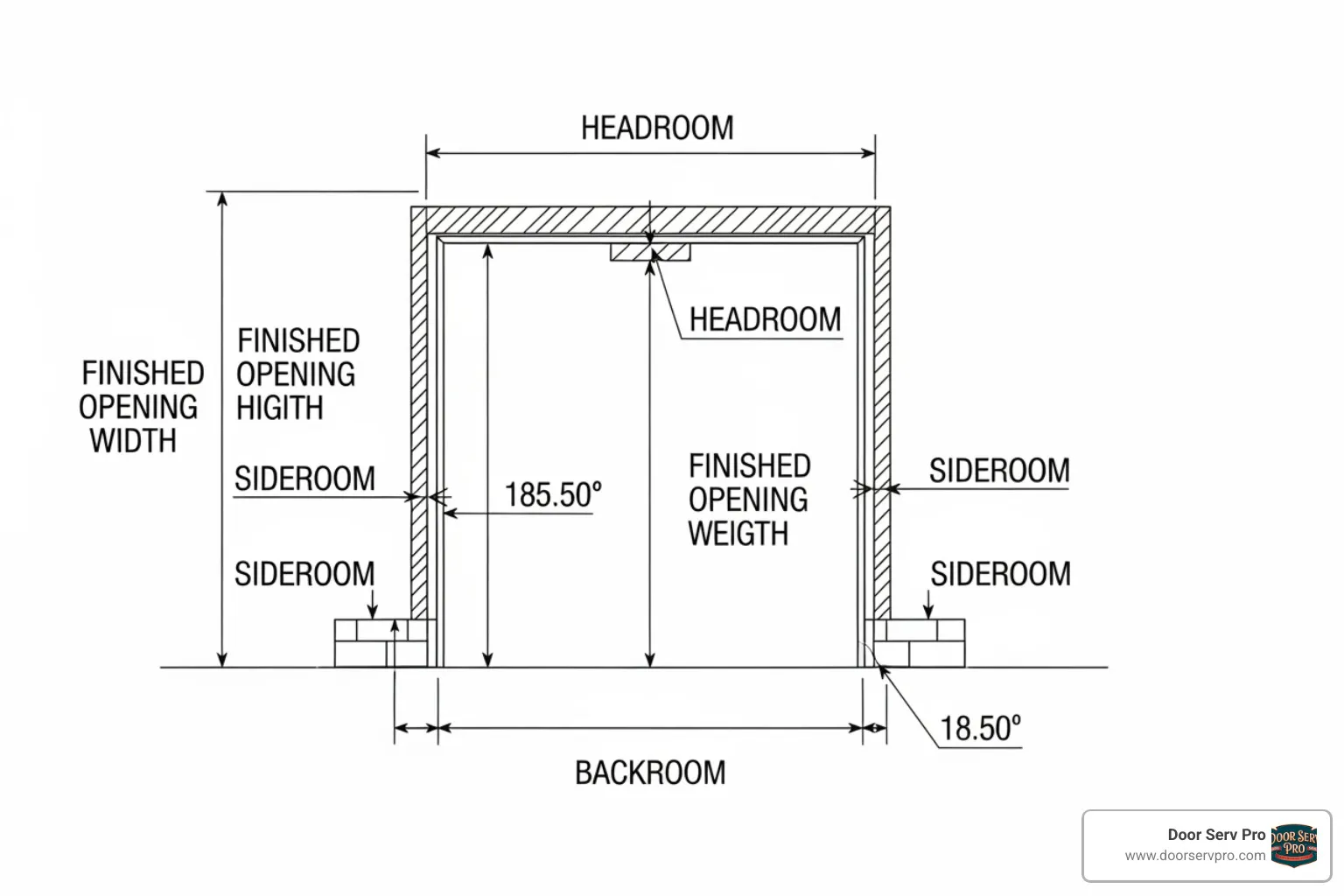
- Finished opening width and height: Measure the opening at its widest and highest points.
- Headroom: Measure the space from the top of the opening to the lowest obstruction on the ceiling (like joists or pipes). Standard systems need 10-12 inches.
- Sideroom: Measure the space on each side of the opening. Most systems need at least 3¾ inches for the vertical tracks.
- Backroom: Measure the depth of the garage from the opening. You'll need the door's height plus at least 18 inches for the tracks and opener.
If your measurements don't match standard door sizes (typically 8-9 ft wide for single, 16 ft for double, and 7 ft high), you may need to modify the opening or order a custom door.
Preparing Your Garage for Installation Day
An unprepared workspace is the biggest cause of delays. Set the stage for success with these steps.
- Clear the workspace: Move everything—cars, bikes, storage shelves, etc.—at least 10 feet away from the garage door opening, both inside and out. This gives installers safe room to maneuver heavy panels.
- Protect personal items: Store belongings away from the work area to protect them from dust and damage.
- Ensure electrical outlet access: If you're installing an automatic opener, make sure a power outlet is accessible near the planned motor location on the ceiling. Avoid using extension cords for permanent installation.
For a complete checklist, see our guide on Preparing for Garage Door Installation. Following these steps ensures a smooth and efficient installation day.
Gearing Up: Tools, Materials, and Critical Safety Precautions
This section details the necessary equipment and highlights the significant safety risks involved, particularly with garage door springs.
Preparing for the garage door installation process requires the right tools and a serious respect for safety. After 25 years in this business, we've seen the consequences of underestimating this job. Here’s what it takes to do it right.
Essential Tools and Materials
While our NATE-certified team arrives fully equipped, it's important to understand what's required. The list is specific and includes a level, power drill, tape measure, various wrenches and sockets, and adjustable locking pliers. Most importantly, winding bars are non-negotiable tools specially designed for handling spring tension; never substitute them with screwdrivers or pry bars. Safety glasses and gloves are mandatory for protection.
Your new door system includes panels, tracks, hinges, rollers, springs, and cables. We always use new hardware designed for your specific door's weight, as mixing old and new components compromises safety and performance.
The Golden Rule: Garage Door Spring Safety
This is the most critical part of the discussion. The springs in your garage door system are under immense tension, capable of causing life-changing injuries or worse. This isn't a scare tactic; it's a fact based on 25 years of experience.
Garage doors use two main types of springs: torsion springs, which sit on a shaft above the door, and extension springs, which run alongside the horizontal tracks. Both store enormous energy to lift a door that can weigh over 400 pounds.
When these springs fail or are mishandled, the results can be catastrophic. A snapping torsion spring can break bones, and a broken extension spring can become a dangerous projectile. This is why professionals exist for this work. We have the specialized winding bars, training, and experience to handle these forces safely.
The risk of a DIY spring installation is simply not worth it. For detailed safety protocols, review our guide on Ensuring a Secure Process. Some jobs are best left to professionals, and this is one of them.
The Core Garage Door Installation Process: A Step-by-Step Breakdown
A detailed look at the major stages of installation, providing insight into the complexity and skill required.
This is the heart of the garage door installation process—a sequence of precise steps where there is no room for error. Each step builds on the last, requiring skill and adherence to safety protocols.
Step 1: Removing the Old Door and Preparing the Opening
Before the new door goes in, the old one must be removed safely.
First, we disconnect the opener by pulling the emergency release and unplugging the unit. Next is the most dangerous step: releasing spring tension. For torsion springs, we use specialized winding bars to slowly unwind the springs. For extension springs, we clamp the door in place before detaching them. One wrong move here can be disastrous, which is why we strongly recommend professional service.
With the tension released, we dismantle the panels from top to bottom and remove all old tracks, rollers, and hardware. We always install a new door with all-new components to ensure system integrity and inspect the wood framing for any necessary reinforcements.
Step 2: Assembling and Installing Panels and Tracks
This is where your new door takes shape, and precision is everything.
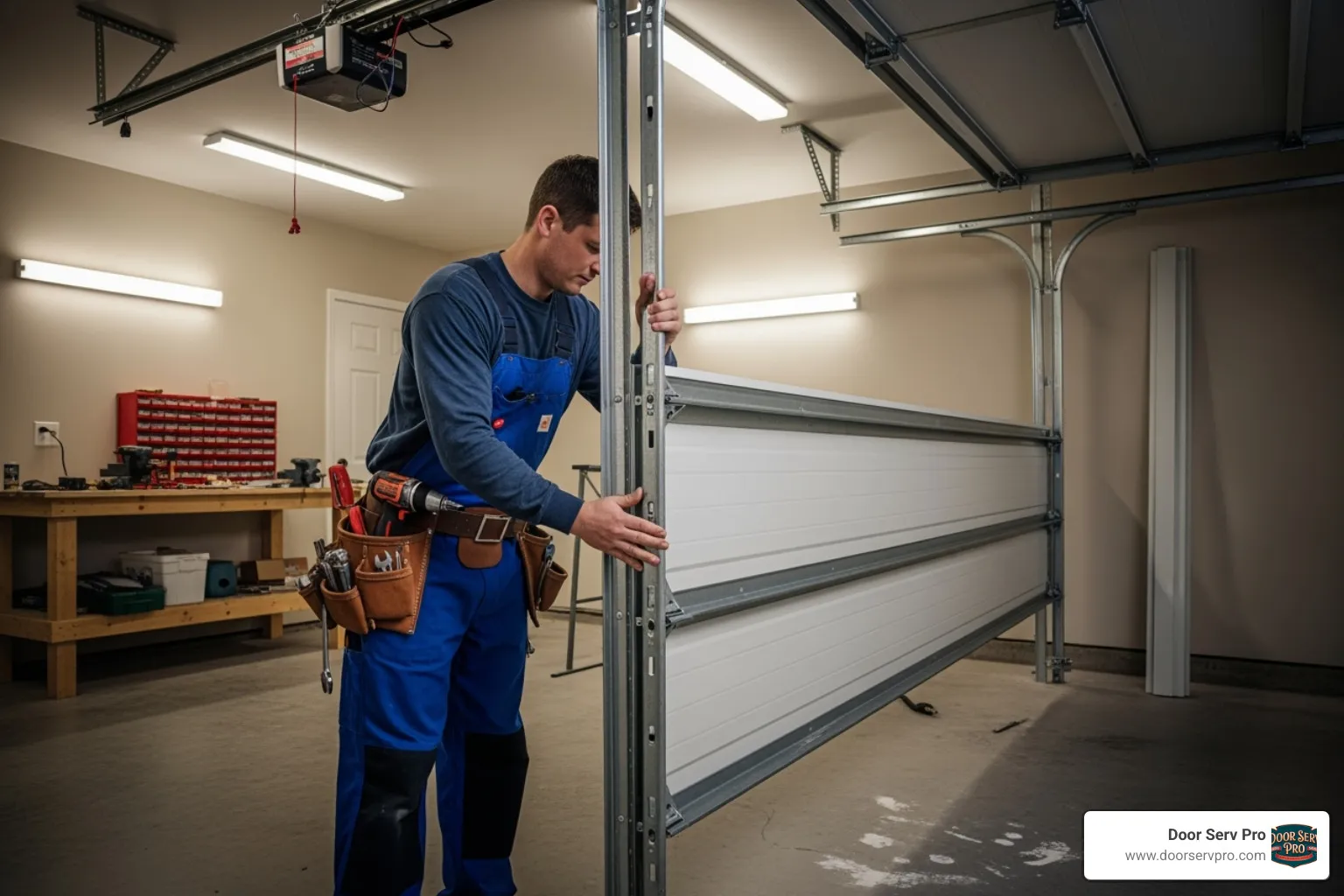
We start by placing the bottom panel in the opening, ensuring it is perfectly level—the entire door's alignment depends on it. We then attach hinges and rollers to each panel as we build upwards. The vertical tracks are installed next, carefully aligned to be perfectly plumb with a slight gap for smooth movement, and secured to the door jambs.
Finally, we assemble and hang the horizontal tracks, connecting them to the vertical tracks and angling them slightly upward toward the back of the garage. This slight slope helps the door stay securely closed.
Step 3: The Heart of the System: A Guide to the Spring Installation Process
This step is what makes a heavy door feel light, and it requires expert knowledge.
Torsion spring installation involves mounting a spring assembly on a shaft above the door. Cables run from the bottom corners of the door up to drums on the shaft. We then use winding bars to carefully apply the precise number of turns, which is calculated based on the door's height and weight. Too much or too little tension will cause problems. The torque involved is immense, making proper tools essential.
Extension spring installation involves stretching springs along the horizontal tracks. We always install safety containment cables through the center of each spring. If a spring breaks, this cable prevents it from flying across your garage.
After securing the entire assembly, we perform the most important final check: balancing the door. A properly balanced door will stay in place when lifted halfway. If it falls or rises on its own, the spring tension is incorrect and must be adjusted. This perfect balance is a hallmark of professional installation.
For more detail, see our Step-by-Step Guide to Installation of Residential Garage Doors.
Step 4: Finalizing a Manual vs. Automatic Door
In the final stage, we bring your door to life.
For manual doors, we install a slide bolt or key-operated lock for simple, reliable security. For automatic doors, we begin the opener installation. This involves securely mounting the motor to a ceiling joist, connecting the drive rail to the door, and installing safety sensors. These photoelectric sensors, required by law, create an invisible beam near the floor that, if broken, immediately reverses the closing door.
We then test all safety features, including the auto-reverse mechanism that stops the door if it hits an obstruction. We fine-tune the open and close limits and ensure the door operates smoothly and quietly. Our guide on Garage Door Installation: Ensuring Smooth Operation covers these technical details.
By the time we're finished, your garage door system is balanced, safe, and ready for decades of reliable service.
After the Install: Checks, Maintenance, and Troubleshooting
Learn how to verify a successful installation and keep your new door running smoothly for years to come.
Once your new door is installed, the final phase of the garage door installation process begins: verification and maintenance. Just like a new car, your garage door needs attention to ensure it performs well for years.
Signs of an Improper Garage Door Installation Process
Subtle warning signs can reveal installation problems that may lead to future headaches. Here's what to look for:
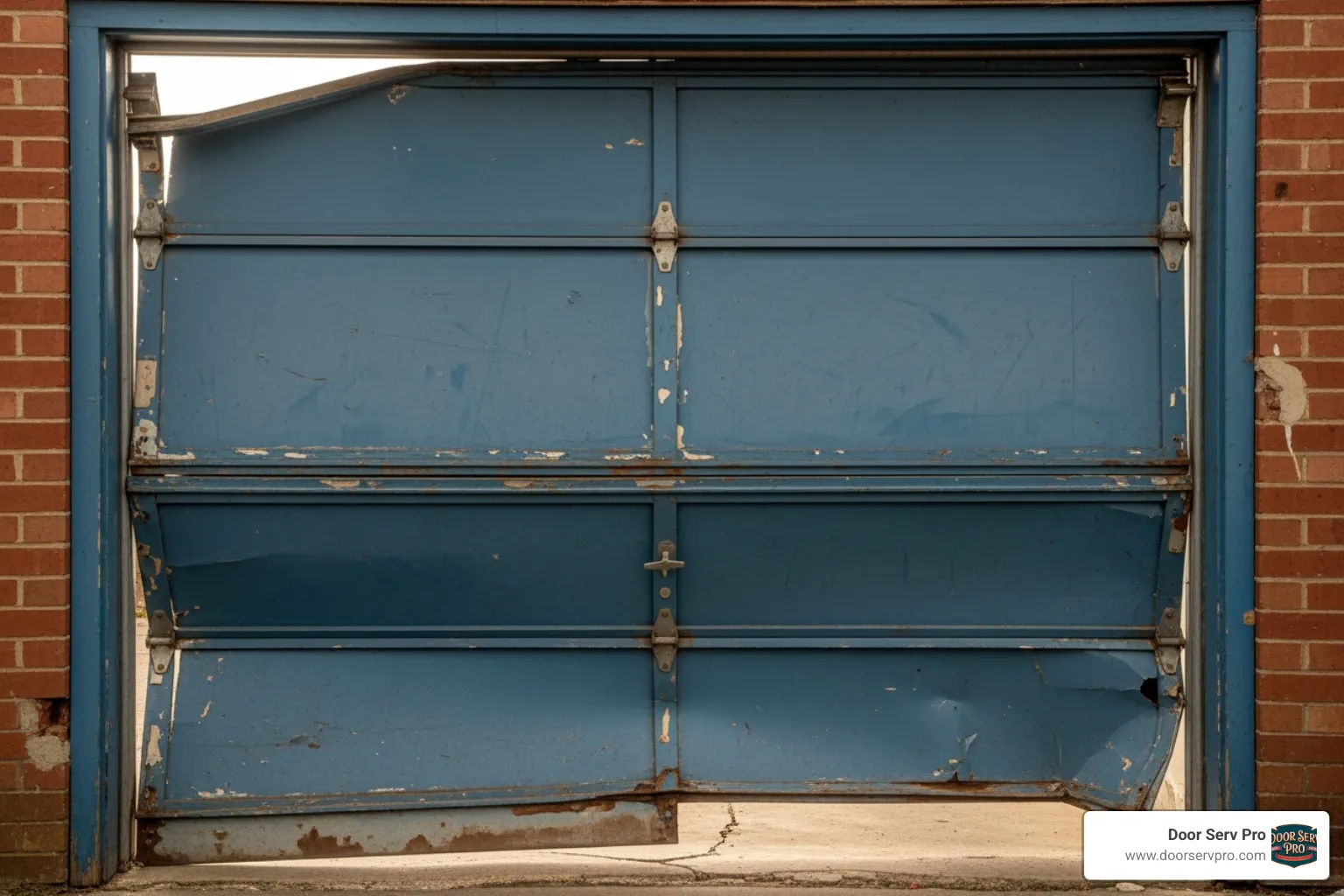
- Uneven gaps: Daylight visible around the closed door indicates poor track alignment, compromising security and insulation.
- Excessive noise: Grinding or banging sounds often mean parts are loose, misaligned, or improperly lubricated.
- Door imbalance: If you disconnect the opener and the door doesn't stay put when lifted halfway, the spring tension is wrong. This strains the opener and is a safety hazard.
- Safety feature failures: The door must reverse when it hits an object or when its sensor beam is broken. Test this monthly.
- Sticking or binding: The door should glide smoothly. Sticking suggests misaligned tracks or damaged parts.
If you notice these signs, contact a professional immediately. Do not attempt to fix them yourself.
Essential Post-Installation Maintenance
A little regular attention will protect your investment. Follow these simple maintenance tips:
- Lubrication: Twice a year, apply garage door lubricant (not WD-40) to all moving metal parts, including hinges, rollers, and springs.
- Hardware Inspection: Seasonally check and tighten all nuts and bolts on hinges and track brackets.
- Test Safety Features: Monthly, place an object like a paper towel roll in the door's path to ensure the auto-reverse and safety sensors work correctly.
- Visual Inspections: Regularly look for worn cables, damaged rollers, or bent tracks. Listen for unusual sounds.
- Professional Tune-ups: An annual service call from a NATE-certified technician can catch problems early and ensure safe operation.
The Value of a Professional Warranty
Choosing professional installation for your garage door installation process provides long-term peace of mind. You get a warranty covering both workmanship and the products themselves, like this 1-year installation warranty example. Professionals use The Importance of Quality Parts designed for your specific door, reducing the risk of premature failure.
At Door Serv Pro, our 100% satisfaction guarantee reflects our confidence in our work. We've been family-owned for over 25 years because we ensure your door operates safely and reliably for decades.
Frequently Asked Questions about the Garage Door Installation Process
Over our 25+ years in the business, we've heard just about every question homeowners have about the garage door installation process. Here are the ones that come up most often.
How much does professional garage door installation typically cost?
Costs vary significantly based on several factors. The size of the door (single vs. double), the material (basic steel vs. custom wood), the style, and the addition of an automatic opener all influence the final price. Location and labor rates also play a role. Because of these variables, we provide personalized quotes to give you an accurate cost for your specific project.
For a more detailed breakdown, see our guide on Understanding Garage Door Installation Costs: What to Expect.
How long does a garage door installation take?
The timeline depends on who does the work. Our NATE-certified team can typically complete the entire garage door installation process in just a few hours. We have a streamlined process that minimizes disruption without compromising on quality or safety.
A DIY installation, however, often takes 8 to 10 hours, and can easily stretch into a full weekend, especially if you run into unexpected challenges like rotted framing or non-standard openings.
What is the most dangerous part of installing a garage door?
Without question, installing and tensioning the springs is the most dangerous part of the garage door installation process. Whether they are torsion or extension springs, they are under extreme tension to lift a door weighing hundreds of pounds.
If mishandled, a spring can snap with incredible force, causing severe injury or even death. The tools used to wind them can become dangerous projectiles. We've seen the aftermath of DIY accidents, and the risk is not worth the potential savings.
This step should always be left to trained professionals who have the specialized tools, training, and insurance to handle these forces safely.
Your Entryway, Perfected: The Final Word on Installation
As we've seen, the garage door installation process is a complex job with significant safety risks. From precise measurements to the dangerous task of tensioning springs, it demands expertise that only comes from years of hands-on experience.
While the DIY route might seem tempting to save money, the risks and potential for error far outweigh the benefits. Improperly installed springs can fail catastrophically, misaligned tracks lead to costly repairs, and an unbalanced door creates a safety hazard for your family. These issues can end up costing far more than a professional installation.
Professional installation from our NATE-certified technicians at Door Serv Pro provides peace of mind. You get the benefit of our expertise, specialized tools, and a 100% satisfaction guarantee. We ensure the job is done right the first time.
Your garage door is a major feature of your home's curb appeal and security. This important investment deserves the precision and care that only experienced professionals can provide. With over 25 years of expertise serving families across WV, VA, PA, and MD, our family-owned company is committed to quality and reliability.
For expert service in Middletown, VA, and surrounding areas, contact us for your garage door needs. Let us help you create an entryway that is safe, beautiful, and built to last.
